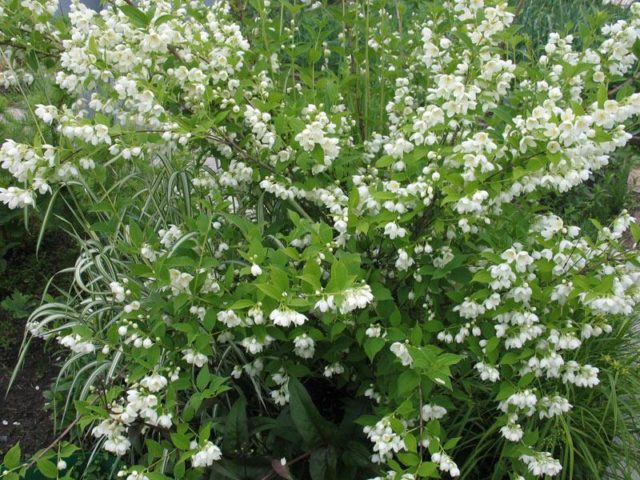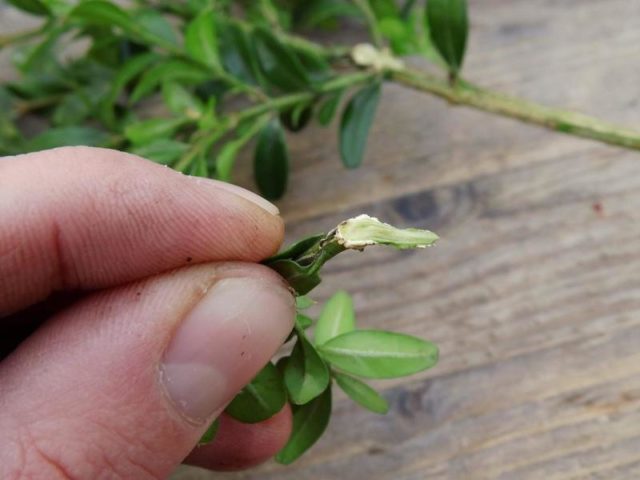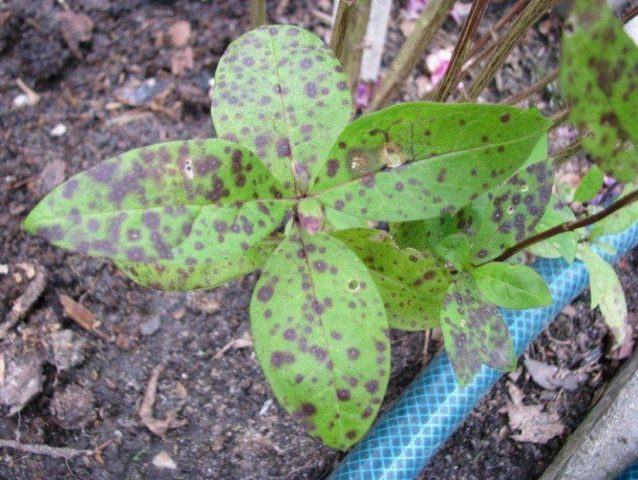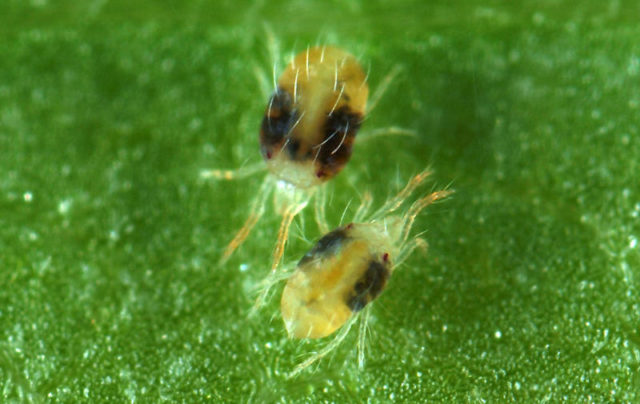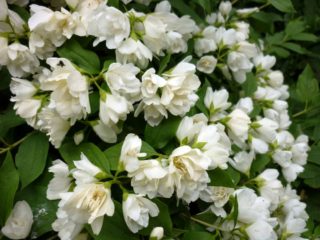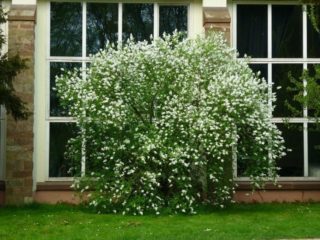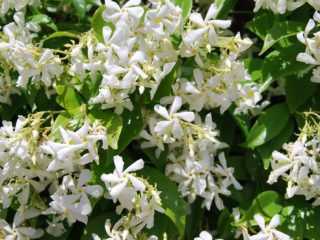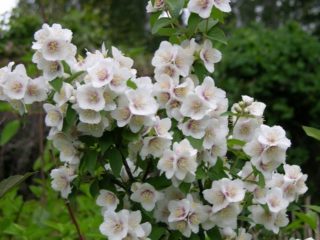Content
Photo and description of the chubushnik Airborne assault is similar to jasmine. But these two species differ in belonging to different families and principles of care. French jasmines became the prototype for the creation of frost-resistant flowering shrubs by Academician N.K. Vekhov.
Description of Jasmine Airborne Troopers
Chubushnik Airborne assault forces form a compact green bush over two meters high. Green oval leaves cover the shrub abundantly. Chubushnik is unpretentious and blooms for a long time even when planted in partial shade.
How jasmine blooms Airborne
The chubushnik received the name Airborne Assault because of the shape of the flowers. The inflorescences that cover the bush in early spring are composed of simple white flowers that look like small parachutes.
Jasmine Airborne Troopers photo of flowers:
Erect two-meter shoots are flexible and plastic. Under the weight of leaves and flowers, they tilt, creating a snow-white fountain during flowering. Due to its unique aroma with hints of strawberries, this variety of garden jasmine is sometimes called Strawberry. Abundant and long flowering from the beginning of May to almost mid-summer is a distinctive feature of the Vekhi mock-orange.
For abundant flowering, the mock-orange requires nutritious soil and regular feeding.
Main characteristics
All types of chubushnik are winter-hardy. This is one of the main differences between the shrub of the Hortensia family and the thermophilic jasmine, which is grown in our climate as a room crop. The Airborne assortment perfectly tolerates the winter cold in central Russia. When grown in northern regions with harsher conditions, the shrub is covered. The unripe shoots of the chubushnik Airborne assault may be partially affected if the snow cover is insufficient for shelter.
One of the tasks of Academician Vekhov was to create varieties of "false jasmine" that do not require much maintenance. Airborne assault is one of the most disease and pest resistant varieties.
Breeding features
Chubushnik is propagated by seeds and vegetative methods. But, given that the varietal jasmine Airborne landing is a hybrid, it is not recommended to propagate it by seeds. In the process of breeding, the decorative basic qualities of the shrub may be lost.
Chubushnik Airborne assault forces are easiest to propagate by cuttings. A large amount of planting material can be obtained as a result of shaping scraps. For reproduction of the shrub, 15-centimeter shoots are cut with a sharp knife with a small "heel" (part of the annual shoot).
The stalk must contain at least two pairs of leaves. Before planting, the lower leaves are removed completely. The upper ones are shortened by a third to reduce the loss of moisture during the period of growing roots.
Shoots are planted in a nutritious soil from a mixture of fertile soil and sand. The rooting process is carried out in greenhouses. At the same time, it is imperative to monitor the moisture of the soil mixture. To protect future seedlings from fungus, it is necessary to ventilate the cuttings daily.
To provide your garden with chubushka for autumn planting, cuttings are cut in the spring or at the very beginning of summer.In this case, the seedlings will be ready for planting in open ground by the end of September.
For planting in the spring, the shoots of the chubushnik are harvested. Airborne assault forces from lignified shoots. Cut them in the fall and store in a cool room. In the second decade of March, cuttings are cut and rooted in the usual way.
Jasmine Layers Airborne Troopers can be propagated throughout the season. For this, the lower branches must be cleaned of leaves and secured with hairpins. Having covered such a layer with soil, you can get a seedling in a couple of months. For rooting, you should water the cuttings in a timely manner.
Planting and caring for jasmine Airborne assault
To grow this unpretentious, luxuriantly flowering shrub in the garden, it is enough to choose the right place and provide minimal care.
Recommended timing
Chubushnik Airborne assault forces are recommended to be planted in a permanent place in the fall. The seedling will have time to take root and winters well if planting is carried out no later than the first decade of October.
It's better to hurry up with a spring planting. The seedling must be placed in a permanent place until the buds swell. Otherwise, the young plant will hurt and may not take root.
Site selection and soil preparation
Chubushnik Airborne troops can develop well enough and bloom in partial shade. But over time, the flowers may become smaller, and the flowering will be less lush. The best place to plant your garden jasmine is in a sunny area with shelter from the wind.
The soil for the chubushnik must be very fertile. After all, the shrub will grow in one place for more than a dozen years. It is imperative to add at least a bucket of high-quality humus to the planting hole in order to provide the seedling with food.
The soil should be neutral or slightly alkaline. Acidic soils are alkalized with ash or lime. The best soil composition for planting a mock-orange is a mixture of peat, leafy earth and sand. It is imperative to fertilize the soil mixture with a complex of minerals.
Landing algorithm
The pit for the chubushnik needs to be prepared large enough. The depth should be such that the root neck is covered by a couple of centimeters. The diameter of the planting hole must be at least half a meter. The distance between the bushes must be left about 1.5 m.When forming hedges, the chubushnik can be planted with an interval of 0.8 - 1 m.
- Lay out the drainage layer (broken brick, tiles).
- Pour a heap of soil at the bottom.
- Remove the seedling from the container and place it on a mound.
- Spread the roots.
- Pour at least a bucket of water.
- Fill the hole evenly, lightly compacting the soil.
- Water the plant from above under the root.
- Mulch with high-moor peat or compost.
Within a few days, the soil in the trunk circle will settle. It is imperative to add soil to the original height. This will stimulate the growth of new shoots. To speed up the development of the bush, weakened shoots can be removed, and the rest can be shortened by a third of the height.
Growing rules
In order for the chubushnik to retain its decorative qualities, it is required to water and feed the shrub in a timely manner. For lush flowering, the plant requires large amounts of nutrients. Be sure to make top dressing. Forming trims will help give your garden jasmine a beautiful shape.
Photo of a chubushnik Airborne landing in a garden design:
Watering schedule
During the flowering period, it is necessary to moisten the soil around the chubushnik abundantly. It is especially important to monitor humidity if the weather is hot and dry. An adult plant can take up to 30 liters of water for one watering.
The shrub is very moisture-loving, although it does not tolerate stagnant water. You can determine the need for watering by the state of the chubushnik foliage. With a lack of leaves, it wilts.
Weeding, loosening, mulching
Do not allow ground tracking in the trunk circle. Lack of air in the root system can cause the development of fungal diseases.Therefore, it is necessary to regularly loosen the soil to a depth of 5 - 6 cm.
The weeds around the bush take away some of the nutrients from the soil. Weeding can be carried out together with loosening, in which it is convenient to remove extraneous roots from the soil.
Watering should be accompanied by mulching. This simple method helps to retain moisture in the soil.
Feeding schedule
If, when planting a mock orange, the soil in the pit was sufficiently nutritious, then the young bush can not be fed in the first year of development. In the future, in the spring, the mock-orange should be fed with mullein solution. One bush requires about a bucket of mortar. After flowering, wood ash is added under the bush when loosening or potassium sulfate - in the form of a solution.
It is advisable to use the full complex of minerals for feeding plants over 3 years old.
Pruning
After winter, branches damaged by frost or pests are cut off at the chubushnik. Once every 5 - 6 years, the bush is rejuvenated by removing old lignified shoots. Anti-aging pruning should be carried out before the start of sap flow.
When the chubushnik has faded, formative pruning is carried out. It is necessary to remove the branches that grow inside the crown and shorten the faded shoots. Shoots of the second year of life are actively blooming.
Preparing for winter
Garden jasmine Airborne troops can withstand temperatures up to 35 degrees. But it is advisable to insulate young plants in this case. For this, the shoots are bent to the ground and covered with spruce branches. Non-woven coverings can be used to protect young plants from the cold.
In the fall, the trunk circle should be covered with peat, compost or a thick layer of dry foliage. This will help keep the root system from freezing.
Pests and diseases
Chubushnik Airborne assault forces are highly resistant to diseases. If not properly cared for, the shrub can be affected by gray rot. The disease manifests itself as a whitish bloom on the leaves. To combat it, the shrub is treated with any fungicide (Skor, Chistolist).
Weakened bushes can also be affected by brown spot. It can be identified by the darkish specks on the leaves. For protection, the shrub is treated with Bordeaux liquid in early spring or autumn.
A spider mite or a voracious aphid is not averse to feasting on the juice of young shoots of a mock-orange. The fight against them consists in insecticide treatments once or twice a season.
In order not to have to fight for the health of the shrub, it is necessary to take care of the cleanliness of the site in a timely manner. Fallen leaves and weeds should be removed regularly. It is they who become one of the main causes of diseases.
Conclusion
Photo and description of the chubushnik Airborne assault forces need to be studied when buying a seedling. It can be provided at a specialty store or nursery. Sellers often confuse this beautiful shrub with other types of mock orange or jasmine.
The airborne assault will decorate the site as a solo landing or hedge.
